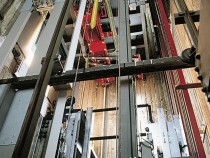
© ThyssenKrupp Aufzugswerke GmbH, Neuhausen a.d.F
Without lifts, high-rise buildings would not be economically viable or functional. Furthermore, in most buildings, the lift shafts form a load-bearing, bracing core and thus an essential part of the overall structure. To meet the needs of tall buildings, whole batteries of lifts are usually required. In the Empire State Building in New York, for example, there are 72; in the Sears Tower in Chicago, 104; and in the Jin Mao Building, Shanghai, as many as 130. Lifts occupy a large part of the space of a building, however, and reduce the commercially exploitable proportion of the floor area. The higher and more slender a building is, the more pronounced this will be. What is more, large sections of the lift shafts are unused at any one time. To ensure a more efficient use of this space, therefore, concepts have been developed that allow a lift shaft to accommodate a number of cars above each other. One solution is the double-decker lift, which is found especially in the US and the Far East, but the coupling of two cabins has a number of disadvantages.



